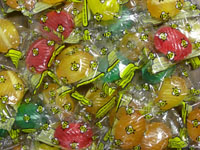Description
Artificial nests will attract various species of native bees such as mason bees and leaf-cutter bees. In Wisconsin there are approximately 400 verified species of native bees. There are 13 species of bumblebees, 200 species of black or black striped bees which include the mining bees, sweat bees and cellophane bees. There are 7 species of blue bees including the mason, including the blue orchard mason bee, and carpenter bees. In addition, there are also green sweat bees in Wisconsin.
Nearly all the native bees are solitary; bumblebees are the only native bee that lives in a social colony. Seventy percent of the solitary bees are ground nesting, finding homes in bare ground, sand piles or pits of sand. The remainder are cavity or stem nesters.
Placement of Native Bee Nests
In early spring, place the nest in a sheltered location, such as under eaves or on the side of a building. Face the nest east so it receives morning sun but is shaded in the afternoon. If placing a wooden nest box or stem container on a pole, secure it well so that the nest will not move; movement disrupts nesting and larval development.
Care of Native Bee Nests
While some new bees emerge in the same season in which they are laid, most will overwinter and emerge the following spring; some do not emerge until the spring after that. Nests can be left outdoors for the winter. Because artificial nests concentrate a large number of bees in a small area, they can harbor parasites and disease. Artificial nests must be disinfected and phased out to prevent harming wild be populations. To disinfect the empty nest, submerge in a solution of 1 part bleach to 3 parts water.
If using a wood nest with tubes, remove the tubes at season’s end with bee larvae still in them and refrigerate.





Reviews
There are no reviews yet.